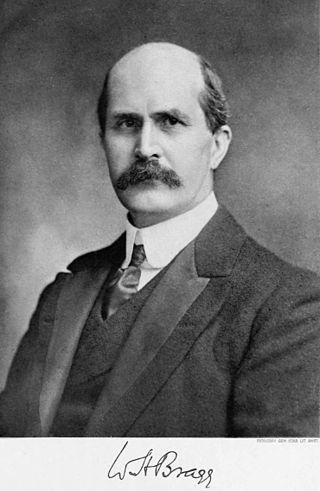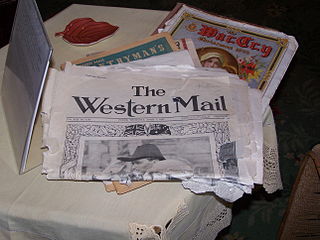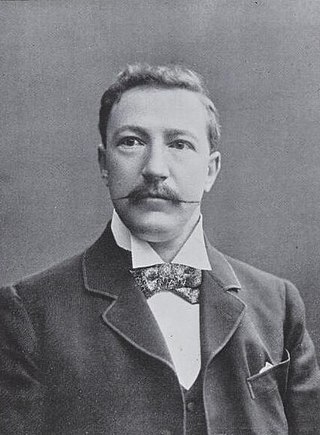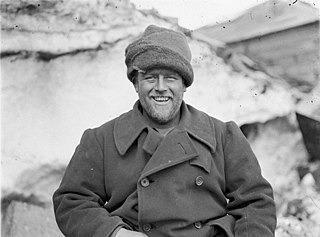Related Research Articles

Rottnest Island, often colloquially referred to as "Rotto", is a 19 km2 (7.3 sq mi) island off the coast of Western Australia, located 18 km (11 mi) west of Fremantle. A sandy, low-lying island formed on a base of aeolianite limestone, Rottnest is an A-class reserve, the highest level of protection afforded to public land.

Sir William Henry Bragg was an English physicist, chemist, mathematician, and active sportsman who uniquely shared a Nobel Prize with his son Lawrence Bragg – the 1915 Nobel Prize in Physics: "for their services in the analysis of crystal structure by means of X-rays". The mineral Braggite is named after him and his son. He was knighted in 1920.

ABC Radio Perth is the on-air identifier of a radio station located in Perth, Western Australia, operated by the Australian Broadcasting Corporation, and broadcasting at 720 kHz AM. It is the flagship ABC Local Radio station in Western Australia. The station was established under the Sealed Set scheme by Westralian Farmers in 1924, sold to the Commonwealth Government in 1928 and provided with programmes by the Australian Broadcasting Company, became part of the Australian Broadcasting Commission in 1932, which became the Australian Broadcasting Corporation in 1983.

The Western Mail, or Western Mail, was the name of two weekly newspapers published in Perth, Western Australia.
Sidney Harry Jeffryes was an early Australian wireless telegraphy operator. Trained by Australasian Wireless Co., Ltd., he was initially employed on coastal shipping and established at least one record for distance transmission. But he is best known for his service as the wireless officer at Cape Denison during the second year of the Australasian Antarctic Expedition under the command of explorer Douglas Mawson. His service ended in September 1913, two months prior to the relief of the shore party, when Jeffryes developed symptoms of paranoia and had to be relieved of his duties.

Rottnest Island lies 18 kilometres (11 mi) west of the coastline of Perth, Western Australia; it is 4.5 kilometres (2.8 mi) at its widest and 11 kilometres (6.8 mi) at its longest.

Sir Hugh Robert Denison, originally Hugh Robert Dixson was a businessman, parliamentarian and philanthropist in South Australia and later New South Wales. He was a member of the South Australian House of Assembly from 1901 to 1905, representing North Adelaide (1901-1902) and Adelaide (1902-1905). Outside of politics, he was involved in his family's tobacco business, a forerunner of the British-Australasian Tobacco Company, was involved with a number of newspapers, and founded the Macquarie Broadcasting Services Pty Ltd radio network. He changed his surname by deed poll in 1907 to avoid confusion with his uncle Sir Hugh Dixson.

Edward Gustavus Campbell Barton was an electrical engineer and a member of the Queensland Legislative Assembly.
The history of broadcasting in Australia has been shaped for over a century by the problem of communication across long distances, coupled with a strong base in a wealthy society with a deep taste for aural communications in a silent landscape. Australia developed its own system, through its own engineers, manufacturers, retailers, newspapers, entertainment services, and news agencies. The government set up the first radio system, and business interests marginalized the hobbyists and amateurs. The Labor Party was especially interested in radio because it allowed them to bypass the newspapers, which were mostly controlled by the opposition. Both parties agreed on the need for a national system, and in 1932 set up the Australian Broadcasting Commission, as a government agency that was largely separate from political interference.

Walter Henry Hannam (1885–1965) was an Australian wireless experimenter, a founding member of the Wireless Institute of Australia, wireless operator and mechanic on the Australasian Antarctic Expedition, a member of the ANZAC Wireless Company in World War I, and tireless promoter of amateur radio in the 1920s.
Henry Walter Jenvey was a senior public servant, initially with the Victorian Post Office and following Federation, the federal Postmaster-General's Department. He was heavily involved in the development of Victoria's telegraphy and telephony networks, and subsequently their integration into those of the Commonwealth. One of Australia's earliest wireless experimenters, he could reasonably be described as Australia's first amateur radio operator, since the majority of his experiments was self-funded and in his private time.
Edward Hope Kirkby was a jeweler watchmaker in Williamstown, Victoria who eventually became a manufacturing electrician making systems of fire protection. He is best known for his early X-ray experiments and later wireless experiments, among the earliest in Australia. He experimented on his own account and together with George Augustine Taylor. There are no primary references to George Taylor experimenting with wireless telegraphy himself. Kirkby was the technical genius behind Father Shaw and his Australian Wireless Company.
Philip Billingsley Walker was a senior public servant with the New South Wales Post and Telegraph Department. He was heavily involved in the development of New South Wales' telegraphy and telephony networks. Notable for conducting one of the earliest wireless telegraphy experiments in Australia.
John Yeates Nelson was a senior public servant with the Post and Telegraph Department of New South Wales, Australia and later the Australian Federal Postmaster-General's Department. He was heavily involved in the development of Australia's telegraphy and telephony networks. Nelson is notable for assisting with one of the earliest wireless telegraphy experiments in Australia.
Oswald Francis Mingay was a public servant, wireless signalman in the Australian Army during World War I, and an early wireless experimenter. He was, however, best known as a journalist, editor, and publisher of radio-related publications over several decades. He was radio manager for Burgin Electric, and influenced that firm to establish Australia's first Class B broadcasting station in 1924.
Australasian Wireless relates to two separate entities: Australasian Wireless Limited and Australasian Wireless Company Limited. The former obtained an option to acquire the exclusive rights to the Telefunken wireless telegraphy system in Australasia, the latter acquired those rights and with public capital developed a firm which was successful in supplying wireless telegraphy equipment to shipping in Australasian waters and the establishment of Australia's first coastal radio stations. When the Australian Government decided to complete the remainder of the coastal network using the Balsillie wireless system manufactured by Father Archibald Shaw, AWCL merged with Marconi interests to form Amalgamated Wireless (Australasia). This merged firm eventually won the exclusive right to operate Australia's coastal radio network and went on to become the dominant company in Australia's radiocommunications and broadcasting industry.
John Graeme Balsillie was an inventor, communications engineer, wireless telegraphy pioneer, business proprietor and senior public servant. He is perhaps best known for oversighting the establishment of Australia's first coastal radio network which utilised a wireless telegraphy system patented by himself and generally known as the Australian system. Born in Brisbane, Queensland, he migrated with his family to London. His studies focused from an early age upon wireless telegraphy and soon found employment in that rapidly developing industry. After a decade of wireless experience, he was recruited by the then Prime Minister Fisher as the "Commonwealth Wireless Telegraphy Expert." He helped to develop the Australian Wireless System free of royalty, jump-starting the nation's radio communications network. The coastal radio network was completed in time to play a significant part in Australia's defence of its borders in World War I.
For a more comprehensive treatment with full quotes of newspaper articles refer Wikibooks chapter on VIN Geraldton
References
- ↑ "LONG PUBLIC SERVICE". The West Australian . Vol. 57, no. 17, 278. Western Australia. 21 November 1941. p. 6. Retrieved 30 March 2018– via National Library of Australia.
- ↑ Martin & Associated Families in Australia 1830 - 2017
- ↑ "LONG PUBLIC SERVICE". The West Australian . Vol. 57, no. 17, 278. Western Australia. 21 November 1941. p. 6. Retrieved 30 March 2018– via National Library of Australia.
- ↑ "WIRELESS TELEGRAPHY". The West Australian . Vol. 15, no. 4, 019. Western Australia. 17 January 1899. p. 7. Retrieved 8 March 2018– via National Library of Australia.
- ↑ "WIRELESS TELEGRAPHY". The West Australian . Vol. 15, no. 4, 125. Western Australia. 22 May 1899. p. 3. Retrieved 8 March 2018– via National Library of Australia.
- ↑ "CITY OF YORK". Kalgoorlie Miner . Vol. 4, no. 1126. Western Australia. 17 July 1899. p. 5. Retrieved 12 March 2018– via National Library of Australia.
- ↑ "GENERAL NEWS". The Inquirer and Commercial News . Vol. LVIII, no. 3, 256. Western Australia. 8 September 1899. p. 10. Retrieved 8 March 2018– via National Library of Australia.
- ↑ "WIRELESS TELEGRAPHY". The West Australian . Vol. 15, no. 4, 267. Western Australia. 4 November 1899. p. 10. Retrieved 8 March 2018– via National Library of Australia.
- ↑ "WIRELESS TELEGRAPHY". The Inquirer and Commercial News . Vol. LVIII, no. 3, 295. Western Australia. 10 November 1899. p. 5. Retrieved 8 March 2018– via National Library of Australia.
- ↑ "THE ROTTNEST CABLE". The Daily News. Vol. XVII, no. 7, 680. Western Australia. 6 March 1900. p. 4. Retrieved 8 March 2018– via National Library of Australia.
- ↑ "UNIVERSITY EXTENSION LECTURES". The Daily News. Vol. XXI, no. 8, 415. Western Australia. 11 August 1902. p. 1. Retrieved 8 March 2018– via National Library of Australia.
- ↑ "NEWS AND NOTES". The West Australian . Vol. XXII, no. 6, 179. Western Australia. 6 January 1906. p. 11. Retrieved 8 March 2018– via National Library of Australia.
- ↑ "LONG PUBLIC SERVICE". The West Australian . Vol. 57, no. 17, 278. Western Australia. 21 November 1941. p. 6. Retrieved 30 March 2018– via National Library of Australia.
- ↑ "LONG PUBLIC SERVICE". The West Australian . Vol. 57, no. 17, 278. Western Australia. 21 November 1941. p. 6. Retrieved 30 March 2018– via National Library of Australia.